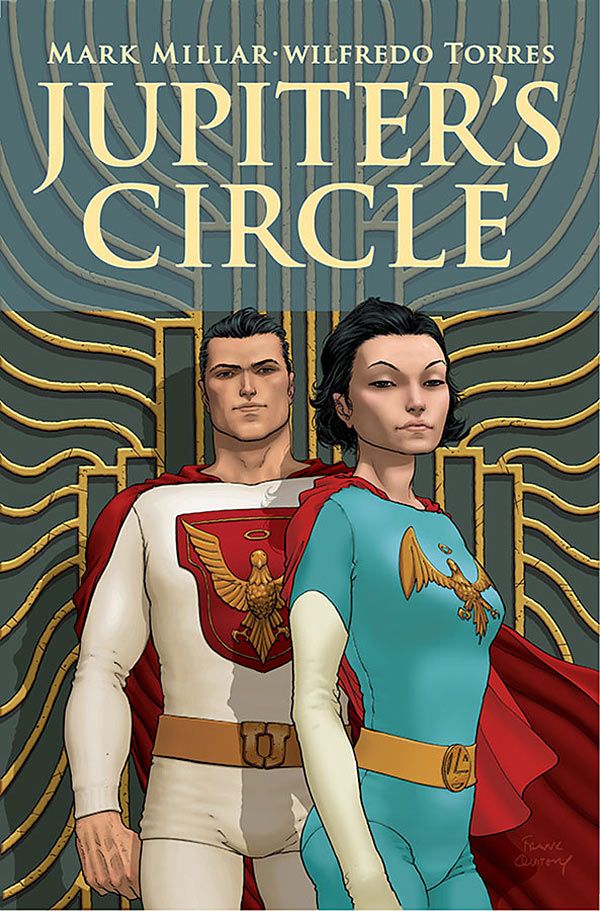With a variant cover reminiscent of "The Super Friends" and a headquarters facade not unlike the famous Hall of Justice welcoming readers to the first page, "Jupiter's Circle" #1 takes readers back to the 1950s in a story written by Mark Millar and drawn by Wilfredo Torres. On the surface, this is a bright, shiny era of superheroes as America rebounds, regroups and starts looking towards tomorrow. It's also a time when conservatism and conformity are encouraged and anything of a "deviant" nature is hunted, shoved into a closet or used as blackmail.
Naturally, that makes "Jupiter's Circle" #1 fertile ground for writer Mark Millar to investigate the secret lives of superheroes as the elder heroes from "Jupiter's Legacy" are visited in their prime. The six heroes are here, but Millar prefers to introduce them to readers as flawed humans rather than heroes. Only Blue Bolt is referred to by his nom de guerre. Everyone else is introduced to readers by their given, uncostumed names. Grace, Bob, Walter, Sheldon and George join Richard Conrad (Blue Bolt) to counter an attack by an extraterrestrial cephalopod.
As it turns out, Conrad is given the greatest breadth of the spotlight while he attempts to keep his relationship choices as secret as his identity. Millar makes no secret that Conrad prefers the company and touch of men, nor does he hide the tyranny with which such behavior is hunted down. As a matter of fact, Conrad's choices set up the drama for the story despite the range of personalities that could be examined. This is, truly, a personal tale of one man's struggles to find his path once everyone else leaves the room.
Of course, the "room" in the issue's 1958 is the heroes' headquarters. Wilfredo Torres decorates the meeting place with trophies and prototypical decor. He doesn't overdo the detail of any setting but simply gives readers more than enough to join in the narrative and complete the imagery. There are plenty of shadowy scenes and moments that are implied rather than explicit, but Torres' storytelling is clear and direct.
He could stand to switch up the coifs, faces and builds of the male characters a bit, as some of the characters either have a bit of sameface going on or simply don't have enough distinguishing features. For example, later in the issue, Danny's character actually looks similar to Conrad's appearance in the early pages of "Jupiter's Circle"#1. This could receive an assist from occasional scene and/or character identifiers but, truly, new readers aren't the target audience of what Millar and Torres are doing here. True, there isn't a great deal that Torres could do, but his style is significantly looser than, say, Quitely's and the characters get a little muddy between that and some minor color inconsistencies. Otherwise, Torres' art is spot on for the era.
Ive Svorcina's colors are also on the mark for the era. The tones are bold and flat. Svorcina doesn't go so far as to reduce every shade to Ben-Day dots, but gradients and shaded areas are kept to a minimum.
When there is need for a color shift, heavy brushes are used to give the colors a damper feel, which keeps everything bright. In keeping with the visual retro feel, Peter Doherty brings balloons with long curvy tails on every word balloon. Sound effects are kept to a minimum and, when they do appear, they seem hand-drawn.
Twenty-three pages of story that include appearances by J. Edgar Hoover and Katharine Hepburn set "Jupiter's Circle" #1 up for an interesting, reality-tinged run with a different perspective on the heroic ideal. Readers steeped in Millar's other creations, specifically "Jupiter's Legacy," will certainly find more in the pages of this comic book, but this first issue mixes bits of the Golden Age, "The Amazing Adventures of Kavalier and Clay" and "Mad Men" with some subtle innuendos and not-so-subtle overtones. "Jupiter's Circle" #1 is a story about what happens when the spotlights are turned away and the potential personal pursuits can play in professional endeavors, especially pursuits that are not commonly accepted, as is the standard for 1950s America.

